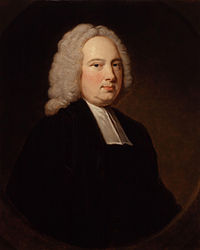James Bradley
James Bradley FRS (1693 – 13 July 1762) was an English astronomer.[1] He was born in Sherborne, Gloucestershire, England.[1] Bradley was educated at Northleach Grammar School and at Balliol College, Oxford.[2] He received a Bachelor of Arts degree in 1714 and a Master of Arts in 1717.[1]

He became a member of the clergy and received an income at Bridstow in Herefordshire.[3] Because of his friendship with Edmond Halley, in 1718 he was elected as a fellow of the Royal Society.[3] He gave up his living at Bridstow to become a professor at Oxford in 1721.[3] Bradley succeeded Edmond Halley as Astronomer Royal at the Royal Observatory, Greenwich in 1742.[3] He held this post until his death in 1762.[3]In 1729 he published his discovery of the aberration of light (also called astronomical aberration).[2] This was he first observational proof of the Copernican Hypothesis that the Sun is at the centre of the Solar System and not the Earth. He noticed a motion in the stars that did not fit the accepted pattern of the time.[4] What he discovered was stellar aberration.[4] In 1748 he published his discovery.[3] That same year he was awarded the Copley Medal from the Royal Society for his discovery.[3]
References
change- ↑ 1.0 1.1 1.2 "James Bradley". NNDB. Retrieved December 2, 2016.
- ↑ 2.0 2.1 The Riverside Dictionary of Biography (Boston: Houghton Mifflin, 2005), p. 109
- ↑ 3.0 3.1 3.2 3.3 3.4 3.5 3.6 "James Bradley (1693-1762)". Michael W. Davidson/The Florida State University. Retrieved December 2, 2016.
- ↑ 4.0 4.1 Joseph Sant. "Copernicanism and Stellar Parallax". scientus.org. Retrieved December 2, 2016.